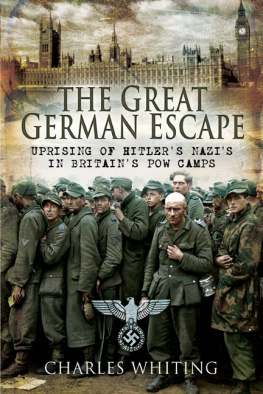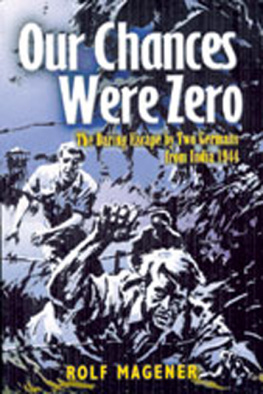

First published in Great Britain in 1992 as The March On London and reprinted in this format in 2009 and 2010 by
PEN & SWORD MILITARY
Pen & Sword Books Ltd
47 Church Street
Barnsley
South Yorkshire
S70 2AS
Copyright Charles Whiting, 1992, 2009, 2010
ISBN 978 1 84884 032 4
eISBN 9781844684588
The right of Charles Whiting to be identified as Author of this work has been asserted by him in accordance with the Copyright, Designs and Patents Act 1988.
A CIP catalogue record for this book is available from the British Library
All rights reserved. No part of this book may be reproduced or transmitted in any form or by any means, electronic or mechanical including photocopying, recording or by any information storage and retrieval system, without permission from the Publisher in writing.
Typeset and printed in Great Britain by
CPI Antony Rowe, Chippenham, Wiltshire
Pen & Sword Books Ltd incorporates the Imprints of Pen & Sword Aviation, Pen & Sword Family History, Pen & Sword Maritime, Pen & Sword Military, Wharncliffe Local History, Pen & Sword Select, Pen & Sword Military Classics, Leo Cooper, Remember When, Seaforth Publishing and Frontline Publishing
For a complete list of Pen & Sword titles please contact
PEN & SWORD BOOKS LIMITED
47 Church Street, Barnsley, South Yorkshire, S70 2AS, England
E-mail: enquiries@pen-and-sword.co.uk
Website: www.pen-and-sword.co.uk

Baron Freiherr von der Heydte came from the Bavarian Altadel , the old aristocracy (p. 10).

Where it all started: Le Marchant Camp, Devizes, now officially known as Camp 23 (p. 40).

The London Cage was a cream-coloured Georgian building at No.8, Kensington Palace Gardens (p.35).

Soldiers of the Big Red One find an abandoned parachute near Mont Rigi.

These two German soldiers, taken prisoner in the Ardennes, indicate the extreme youth of the reserves upon which Hitler was drawing by the winter of 1944/45.

Swift justice is meted out to German soldiers found behind the Allied lines dressed in US uniform.

The prisoner-of-war camp, Thirkleby, North Yorkshire.

Eden Camp, Malton, is now a tourist attraction.
Another aspect of the Germans thorough plans was the amazing scheme, somehow transmitted to Britain, for a break by all German prisoners of war. By all odds the most Wellsian phase of the German war of nerves, it has still not been completely explained. We do know that German prisoners began organizing for a mass break; that they plotted to seize arsenals, obtain tanks and actually prepare the way for German landings in England.
Captain Robert Merriam (official historian to the US Ninth Army in the Second World War)
No escape story of the Second World War was more daring in concept, more fantastic, more ambitious, more hopelessly fanatical than that of the prisoners of Devizes. It began with a bold master-plan for a mass break-out of German POWs from prison camps in wartime Britain.
Colonel Alexander Scotland (head of the British POW Interrogation Service in the Second World War)
ACKNOWLEDGEMENTS
The author would like to thank the following individuals and institutions for the great assistance they have given him with this book: Mr R. Brinkworth; Mrs M. Charles; Mr R. Dyke; Mrs L. Painter (Devizes); Mr R. Beckton; Mr A. Stewart (Sheffield); Mr A. Jacques (Eden Camp, Malton); the various gentlemen of The Old Prisoner-of-War Camp, Thirkleby, North Yorkshire; Mr T. Dickinson of the New York City Public Library System; Kreisverwaltung Monschau, Germany; Mil. Forschungsamt, Freiburg i.B, Germany; Monseiur Fagnoul, St Vith, Belgium; plus the Manchester Evening News.
I would like to take this opportunity to thank all the many readers who have contacted me since my husband died in 2007. He was a very prolific writer as you are aware and his knowledge of military history was phenomenal. I have chosen this book for a reprint because its a cracking story and one where he was the first writer to acquire new evidence of the German POWs plan to march on London.
Gill Whiting
INTRODUCTION
They are not fools, however much we try to persuade ourselves to the contrary. But supposing they had got some tremendous sacred sanction some holy thing, some book or gospelsomething which would cast over the whole ugly mechanism of the German war the glamour of the old torrential raids.
John Buchan
In March, 1945, with only two months of the war to run, some sixty British, French and Belgian officers, plus one Pole, were kicking their heels impatiently at Dormie House at Wentworth, the mock-Tudor premises of Sunningdale golf course. They were all highly experienced members of the SOE, (Special Operations Executive) who had parachuted into Occupied Europe repeatedly to organize resistance to the Germans. The women among them had set up escape routes and had acted as wireless operators. Others had kidnapped a German general in Crete, smuggled arms into Albania, transported V-l and V-2 secrets right across Germany back to Britain. Most of them wore the bright upturned wings and parachute of men and women who had made three or more operational jumps into enemy territory. A week or two before, the authorities had become alarmed at the fate of Allied POWs in German hands. In London, they knew from the MI9 network in POW camps that the Germans had moved the great majority of British and American prisoners to the narrow section of land in Central Germany still under Nazi control. From there the POWs, according to their own secret reports back home, expected to be moved to the Bavarian and Austrian Alps, where it was assumed that the fanatical Nazi rearguard would make its last stand.
In particular, the Allied authorities were worried about the fate of the Prominenten, as the Germans called their most important prisoners. What would the Nazis do with them when they realized the war was lost? Would they use them to blackmail the victorious Allies into concessions? Or would they shoot them out of hand as a last act of spite? Allied Intelligence already knew that Hitler had declared vehemently, Erschiesst sie alle! (Shoot the lot of them).
Next page

























